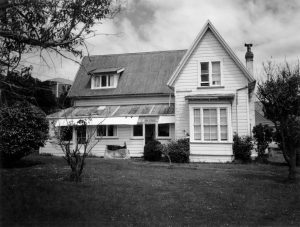
The Wellington suburb of Crofton Downs is known for its steep hills, shopping centre and how several of its streets are named after Winston Churchill (e.g. Winston Street, Churchill Drive, Spencer Street and Downing Street). However, the origin of the suburb’s name can be found in neighbouring Ngaio. Tucked away at the back of a section on the eastern side of Kenya Street lies a house (once part of a larger estate) called ‘Crofton’. Seen today from the street, at a glance you could be forgiven for thinking that it is an example of a 1970s or 1980s faux-colonial cottage, the style of which was popular with house builders during that period. In fact Crofton is one of the oldest surviving houses in Wellington and its early history is connected with some of New Zealand’s most significant figures from the Victorian period.
The house was built in 1857 for William Fox, one of the most polarising NZ politicians of the 19th century. Born in 1812 in County Durham, he started his working life in the UK as a lawyer, moved into journalism, immigrated in 1842 to Wellington where he helped manage the New Zealand Company and finally drifted into politics. As an indication of how tumultuous the political scene was the time, Fox became Premier (i.e. Prime Minister) on four separate occasions between 1856 and 1873. His longest period as ‘PM’ was just over three years but his shortest was only two weeks! Crofton may have been used by Fox and his family as a weekend retreat when they were in Wellington (his parliamentary seat was actually Rangitikei and the town of Foxton is named after him).

In 1864 the house and land was sold to the first Bishop of Wellington, Charles Abraham. He established a ‘grammar’ boarding school on the site, essentially one of the first serious attempts of an institution providing formal secondary education to teenage boys in Wellington. One of its pupils was Henry Hadfield, the first-born son of the missionary Octavius Hadfield. We recently discovered several references to Henry’s education at Crofton in the letters Octavius wrote to his family back in England. These were later repatriated back to NZ, gifted to Wellington City Libraries by Henry’s sister in 1951 and have now been digitised on our Recollect site (click on the caption to see more). Little snippets include how Henry grew quickly and was physically strong for a boy of his age but took a while to find his feet academically and socially. Meanwhile, his father often wondered how he was going to pay his son’s school fees on a reverend’s salary. It is likely that Octavius would have made the journey to Crofton with his son many times via the tortuously steep Old Porirua Road, especially when his friend Rev. Henry Woodford St. Hill purchased the school and became its headmaster. The school closed in 1875 after Wellington College opened on its current site with much better facilities and easier access. The original 14 acres of land which surrounded the house was gradually sub-divided and sold off and the house became a normal residential property.
Its location was originally called Upper Kaiwarra (a corruption of Kaiwharawhara) but in the 1870s the suburb took on the name of the house and the whole area became known as Crofton. Confusingly, around this time William Fox created another estate also called Crofton not far from Marton in Rangitikei which he hoped to develop into a ‘temperance’ (i.e. alcohol free) township. With mailed letters continually ending up in the wrong place, in 1908 the suburb changed its name to Ngaio after the species of tree which are abundant in the area and ‘Crofton’ fell into disuse. Then in the 1950s, a neighbouring semi-rural area was developed after the addition of a train stop to help make it attractive to commuters and the name re-emerged as the suburb of Crofton Downs. As to the source of the original name that William Fox gave his property, the most likely explanation is that it came from the small village of Crofton in Wiltshire where his wife Sarah Halcomb was possibly born or her family may have owned land. As village lacked a church, she was christened in the neighbouring town of Marlborough only a few kilometres away in 1816.

